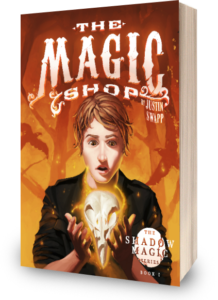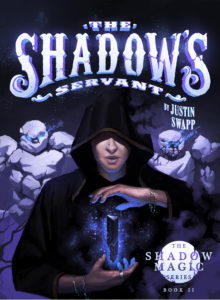Book Publishing and Marketing: 5 Questions for Author Justin Swapp
By Elizabeth Mays |
It’s not everyday you meet an accomplished indie book author who is also an M.B.A. Justin Swapp, author of The Shadow Magic Series, produced the ebook version of his novel The Magic Shop using Pressbooks.com. He took time out from writing the sequel to share his insights on book publishing, marketing and the power to self-publish.
Pressbooks: Tell us about the series.
Justin Swapp: The Shadow Magic series follows Marcus Fith and his sister Ellie as they discover a series of secrets their family has been keeping from them. They live in the loft of their grandparent’s Magic Shop, and as soon as they are asked to start tending it, they uncover clues that set them on an adventure to resolve an ancient family feud. They learn that that the store is a front, and they were marked to die at an early age.
The series is filled with twists and turns and shady characters. Book One recently was recently honored in the Notable category of Shelf Unbound Magazine’s Middle Grade selection of books.
P.B.: What has the ability to take ownership of publishing your book meant for you, and how would you advise aspiring authors in your genre to approach independent publishing?
J.S.: I’ll answer that question a little bit out of order. It’s a big decision that authors face today, whether to publish independently or to suffer through the acquisition portion of the old publishing process. In my case, I literally didn’t send my book off to a single agent, nor to a publishing house. I literally didn’t want to go through the months, or years, of waiting – not when I knew how resourceful I could be. Also, I knew my book had already been seen and critiqued by hundreds of folks participating in my various writing groups.
So, for me, the ability to research solutions that would enable me to produce a quality book as quickly as possible was key. I found Scrivener as a writing tool (word processing,) and DeviantArt for an artist that would do a great book cover (I ended up with Arthur Wang Art, and have never looked back), and finally I found Pressbooks. More and more traditionally published authors I read on social media were talking about how the publishing houses were doing less and less for them. So, it was a revelation. If I could produce a quality book with the tools out there today, and the traditional publishers were doing less and less, the decision was a bit of a foregone conclusion in my head.
Pressbooks was a particularly amazing find, and I mean that sincerely. Presbooks is built on top of WordPress, a blogging / website platform I’m already familiar from my time spent on my own website. This enabled me to jump right in and literally control everything about my ebook as if I already knew how to operate Pressbooks. As a side note, I’m actually a bit of an early adopter. I actually try almost every new service that comes out. From my perspective, nothing compares to how easy Pressbooks is. You write your book, upload the text, organize it some, and hit the “export” button. Bam! Can’t get any easier than that.
As far advice goes for aspiring authors, I’d say several things.
- Read, and write a lot.
- Come up with your writing flow/processes.
- Trust the process. Don’t be afraid. Don’t get down. It’s self-doubt and the like that derails 80 percent of writers.
- Join a writers group. Listen to the feedback. It will be scathing, and if you’re humble and take it like good medicine, you’ll be better for it.
- Actually finish. You laugh, but you’ll see. Actually finish your work.
- Get the manuscript edited. (Really, edited. Aunt Jackie doesn’t count unless she’s a professional editor.)
- Use the tools at your disposal (Pressbooks, etc.) to turn your project around, and to get it out there quickly. Rinse, repeat.
P.B.: You’ve also had authored books published by traditional publishing houses. What advice do you have for indie authors unsure whether to pursue self-publishing or the traditional route? (And are those mutually exclusive?)
J.S.: My traditional publishing experience was more of a small press situation, but honestly, I loved it. I got picked up for several anthologies, and I met a lot of great folks that I still keep up with a little bit today. It’s fun to watch everyone’s careers progress.
Fundamentally, the question of traditional publishing vs indie publishing comes down to finances and freedom. With traditional publishing, you wait and wait, and you don’t have to. You also are at the mercy of the publisher with regards to picking the cover, and ultimately what portion of the profit you get to keep. In the traditional model, the publisher did a lot of marketing for you.
With indie publishing, it’s all on you. That might sound daunting, but with the right tools, like Pressbooks, Scrivener, DeviantArt and others (those are the tools I use), it’s never been easier. Couple easy with giving me the choice to do the cover the way I want, to distribute through the channels I chose, etc., well, the decision for me was a no-brainer.
P.B. What features in Pressbooks were the most conducive to writing and publishing the book?
J.S.: First of all, I have to say that I love Pressbooks. I’m not just saying that. I found Pressbooks at a time when I wanted to be more concerned with writing, and less concerned with learning another tool to accomplish my goals. That said sincerely, Pressbooks offers many advantages over its competitors.
It’s easy. If you are familiar with WordPress, then you are already almost an expert regarding Pressbooks. It’s truly as easy as uploading your chapters, selecting a theme, and hitting “export.” Then, boom, you get your ebook files. I’m not kidding. It’s like that.
It’s flexible. If you want to create a bunch of front matter or back matter (the parts at the beginning or ending of a book, like a table of contents, or an epilogue,) you can. It’s easy. If you want to add your own graphics for chapter headers, you just upload them, and situate them how you’d like. It’s easy. You can do almost anything you’d like in a super-simple way.
It’s inexpensive. First of all, Pressbooks is free for you to upload and to play with your manuscript in Pressbooks’ platform. Then, if you want to remove the watermarks (you don’t have to, per se) you can pay a nominal fee and unlock the ebook version of your manuscript in all the relevant ebook formats. If you want the print version, it’s a little more expensive, but once you realize what it takes to create a good-looking print format, you’ll understand that the price is VERY inexpensive. Plus, they’re always running promos for you to give it a try and to lock down a print copy slot for your book.
It has great support. If you happen to get lost along the way, Pressbooks has a ton of support options available for you. First of all, they have produced a bunch of how-to videos. You can go to their blog, or their YouTube channel, and watch videos that address a particular question you have, or you can just sit through them all and get an overview of all the features.
Also, they offer real-time support via Twitter and the like. I recently had some questions about adding some drop caps to one of my chapters, and I got a quick response via Twitter, and later a super-detailed response via email. I was honestly surprised they took the time they did to explain the technology to me in email. It was great.
It’s innovative. When you set up an account with Pressbooks, each “book” you create can have a Web address assigned to it. On their blog, Pressbooks has shared some interesting and creative ways authors have used this Web address to give away samples of their book, or to publish magazines or to do different things with their content. They also update their product frequently, something that I have always found to be a sign of a healthy company. They’re thinking and working and pushing the envelope.
P.B.: Writing is not just writing; it’s also a business, particularly for those who self-publish. You have an M.B.A., which must have given you an edge in your career as an author. What business and marketing advice do you have to authors who might not have this background?
J.S.: I’m glad you called out the business and marketing aspect of indie publishing, because this is a big deal. Authors need to understand that once they have written, edited and produced their manuscript – they have an honest-to-goodness product! There is a lot to getting your product out there. People need to not only be aware of it, but buying it! This part of the process is a LOT of work, but in the indie author ranks, no one will do this for you, and it has to be done.
Here are some steps to consider and some hints for each one.
Map out a marketing plan. (Google this–there are templates.) Here’s a super rough plan:
- Create a great product.
- Create awareness of the product, and drive desire for people to buy it.
- Honestly, the one major benefit you get from traditional publishing is their ability to get your name and your product out there. Now, that’s on you alone – at least, that’s what it will feel like at first. Realize, though, that the World Wide Web has changed the world, and it’s no different for the book landscape.
- Get on social media and actually use it. (Facebook, Twitter, Goodreads etc.) Seriously, this is a must have today. Don’t bother pouting.
- There are whole communities out there to help indie writers. Find them, and leverage them. Indie authors help each other. Examples:
- Writer communities: Writing groups, writers helping writers, advice columns, etc.
- Bloggers (People who write reviews about books on their websites)
- Vloggers (Video bloggers)
- Interviews (What I’m doing here)
- Host, or get others to host, giveaways of your book (Goodreads, Rafflecopter etc.)
- Advertising (Buy space on a website like Amazon.com, or other mom and pop websites that have an audience that you’re selling to.)
- Create a “street team” of people who love your book, and get them to spread the word. Incentives don’t hurt.
- And many more!
There are many ways to distribute your book:
Print Books
You have to decide if you want to just distribute the ebook, or if you will go through distributing the print book too.
Many companies are allowing for print on demand (POD) services. This is huge for indie authors and bookstores alike because it doesn’t involve inventory issues (not in the traditional way). Companies like CreateSpace (an Amazon company) and IngramSpark are the frontrunners here, and they allow someone to order your book, and based on that one order, they will print it and get it to them in a timely manner. The modern marvels of technology.
eBooks
This is where I’ve used Pressbooks, and Pressbooks is an all-star. Literally, you click a button, and it spits out the different ebook formats that you can upload to Amazon and other etailers. Note, Pressbooks does print files too. I’m considering using them for my upcoming book, “The Shadow’s Servant.”
Audiobooks
Amazon’s ACX can connect you with indie narrators that are looking for projects. You split the profits.
One-by-one versus syndicated distribution
You can choose to upload your ebook to each ebook “etailer,” (such as Amazon, B&N, Apple, etc.) or you can upload once to a syndicated distributor like smashwords.com or draft2digital.com. They will take a small cut for you uploading it once, and they distribute your eBook to all the different “etailers” they support.
For more information on Justin Swapp, go to justinswapp.com.





